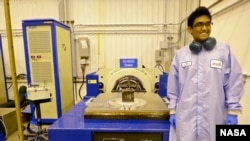A satellite built by U.S. high school students is set to be launched tonight - a first for the U.S. space agency, NASA.
The launch of the privately built Minotaur rocket will carry 29 tiny satellites, known as nanosatellites - or cubesats, into orbit in a scheduled launch at 0030 GMT.
The Orbital Sciences Corporation rocket is launching as an Air Force test program, carrying small satellites. One is an ordinary smartphone NASA converted and another was built by students at Thomas Jefferson High School in Alexandria, Virginia.
The launch marks the first time NASA will launch a cubesat developed by students not yet in college.
"The advancements of the cubesat community are enabling an acceleration of flight-qualified technology that will ripple through the aerospace industry," said Jason Crusan, director of Advanced Exploration Systems, the office that oversees the Cubesat Launch Initiative at NASA Headquarters in Washington. "Our future missions will be standing on the developments the cubesat community has enabled."
According to the Thomas Jefferson High School website about the satellite, known as TJ3Sat, the payload, will allow “students and other amateur radio users the opportunity to send and receive data from the satellite.”
“Onboard the satellite a Text Speak module is used to convert text messages into an analog voice signal,” said the website. “Students and other users from around the world can submit text strings to be uploaded to the TJ3Sat website. Approved text strings will be transmitted to the satellite and the resulting voice interpretation will be relayed back to Earth over an amateur radio frequency using the onboard Stensat radio.”
Since 2010, the cubesat Launch Initiative has issued four announcements of opportunity and selected more than 90 cubesats from public and private institutions and government labs to launch as auxiliary payloads aboard commercial rockets. The cube-shaped satellites are approximately four inches long per unit, have a volume of about one quart and weigh less than three pounds. Cubesat research addresses science, exploration, technology development, education or operations.
More than 300 students took part in this fourth installment of NASA’s cubesat Launch Initiative and it’s Educational Launch of Nanosatellite (ELaNa) Missions, which enables students, teachers and faculty to obtain hands-on flight hardware development experience.
The launch of the privately built Minotaur rocket will carry 29 tiny satellites, known as nanosatellites - or cubesats, into orbit in a scheduled launch at 0030 GMT.
The Orbital Sciences Corporation rocket is launching as an Air Force test program, carrying small satellites. One is an ordinary smartphone NASA converted and another was built by students at Thomas Jefferson High School in Alexandria, Virginia.
The launch marks the first time NASA will launch a cubesat developed by students not yet in college.
"The advancements of the cubesat community are enabling an acceleration of flight-qualified technology that will ripple through the aerospace industry," said Jason Crusan, director of Advanced Exploration Systems, the office that oversees the Cubesat Launch Initiative at NASA Headquarters in Washington. "Our future missions will be standing on the developments the cubesat community has enabled."
According to the Thomas Jefferson High School website about the satellite, known as TJ3Sat, the payload, will allow “students and other amateur radio users the opportunity to send and receive data from the satellite.”
“Onboard the satellite a Text Speak module is used to convert text messages into an analog voice signal,” said the website. “Students and other users from around the world can submit text strings to be uploaded to the TJ3Sat website. Approved text strings will be transmitted to the satellite and the resulting voice interpretation will be relayed back to Earth over an amateur radio frequency using the onboard Stensat radio.”
Since 2010, the cubesat Launch Initiative has issued four announcements of opportunity and selected more than 90 cubesats from public and private institutions and government labs to launch as auxiliary payloads aboard commercial rockets. The cube-shaped satellites are approximately four inches long per unit, have a volume of about one quart and weigh less than three pounds. Cubesat research addresses science, exploration, technology development, education or operations.
More than 300 students took part in this fourth installment of NASA’s cubesat Launch Initiative and it’s Educational Launch of Nanosatellite (ELaNa) Missions, which enables students, teachers and faculty to obtain hands-on flight hardware development experience.









